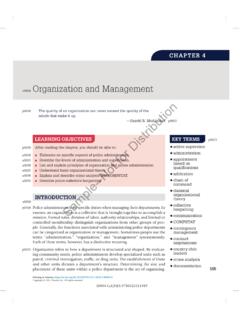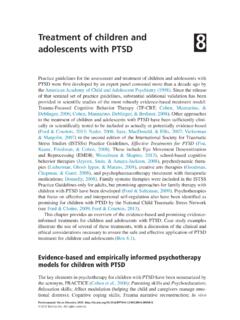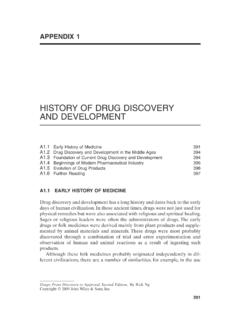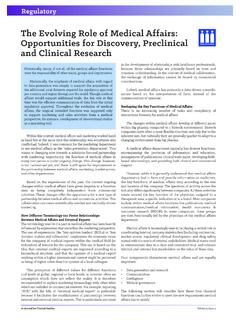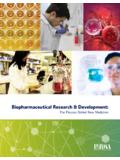Transcription of Chapter 11. The Drug Discovery Process - Elsevier
1 Chapter 11 The drug Discovery ProcessSuccess is the ability to go from failure to failure with no lack of Winston Churchill (1874 1965)I am interested in physical medicine because my father was. I am interested in medical research becauseI believe in it. I am interested in arthritis because I have Bernard Baruch, techniques may be generating bigger haystacks as opposed to more Horrobin, Some Challenges for Modern Target-Based drug Systems-Based drug vivoSystems, Biomarkers, andClinical Types of Therapeutically ActiveLigands: Pharmacology in drug Chemical Sources for Pharmacodynamics and High-Throughput drug Clinical Summary and SOME CHALLENGES FOR MODERNDRUG DISCOVERYThe identification of primary biological activity at the tar-get of interest is just one of a series of requirements for adrug. The capability to screen massive numbers of com-pounds has increased dramatically over the past 10 15years, yet no corresponding increase in successfullylaunched drugs has ensued.
2 As discussed in Chapter 9,there are required pharmacokinetic properties and absenceof toxic effects that must be features of a therapeuticentity. As more attention was paid to absorption, distribu-tion, metabolism, and excretion (ADME) properties ofchemical screening libraries, toxicity, lack of therapeuticefficacy, and differentiation from currently marketeddrugs have become the major problems. As shown inFigure , the number of new drug entities over theyears has decreased. This particular representation is nor-malized against the increasing costs of drug discoveryand development , but it does reflect some debilitatingtrends in the drug Discovery Process . Undue reliance onrobotic screening using simplistic single gene targetapproaches (inappropriate reliance on the genome as aninstruction booklet for new drugs) coupled with a de-emphasis of pharmacological training may have combinedto cause the current deficit in new drugs[2].
3 The lack ofsuccess in drug Discovery is reflected in the number ofdrugs that have failed in the transition from Phase II clini-cal trials (trial in a small number of patients designed todetermine efficacy and acute side effects) to Phase IIIclinical trials (larger trials meant to predict effects inoverall populations and determine overall risk-to-benefitratio of a drug ); seeFigure While 62 to 66% of newdrugs entering Phase I passed from Phase II to Phase IIIin the years 1995 to 1997, this percentage fell to 45% in2001 2002[3]. In view of the constantly increasing num-ber of new drugs offered for clinical trial, this suggeststhat the quality of molecules presented to the clinic isdiminishing compared to that seen 10 years the heart of the strategies for drug discoveries aretwo fundamentally different approaches; one focusing onthe target, in which a molecule is found to interact with a281T.
4 P. Kenakin: A Pharmacology Primer, Fourth edition. DOI: 2014 Elsevier Inc. All rights biological target thought to be pivotal to the dis-ease Process , and one focusing on the complete system. Itis worth considering these TARGET-BASED drug DISCOVERYA target-based strategy for drug Discovery has also beenreferred to as areductionist approach. The term origi-nates in physics, where it describes complex matter at thelevel of fundamental particles. In drug Discovery ,target-basedrefers to the fact that the responsible entity for apathological Process or disease is thought to be a singlegene product (or small group of defined gene products)and is based on the premise that isolation of that geneproduct in a system is the most efficient and least ambig-uous method of determining an active molecule for thetarget. Reductionist approaches are best suited for metoo molecules with well-validated targets when the firstin class already exists.
5 They also are well suited toMendelian diseases such as cystic fibrosis and sickle cellanemia, where the inheritance of a single gene mutationcan be linked to the systems most often are recombinant oneswith the target of interest (for example, human G proteincoupled receptor [GPCR] expressed in a surrogate cell). Thenature of the cell is thought to be immaterial, since the cellis simply a unit reporting activation of the target of example, belief that peptic ulcer healing is facilitated byblockade of histamine H2 receptor-induced acid secretionsuggests a reductionist system involving antagonism of his-tamine response in surrogate cells transfected with humanhistamine H2 receptors. In this case, refining primary activ-ity when the target-based activity disease relationship hasbeen verified is a useful strategy. It can also be argued thatconsiderable value may be mined in this approach, since first in class often is not best in class.
6 Focusing in on a single target may be a way of treat-ing a disease, but not necessarily of curing it. The inter-play of multiple genes and the environment leads tocomplex diseases such as diabetes mellitus, coronaryartery disease, rheumatoid arthritis, and asthma. To con-sider this latter disease, it is known that bronchial asthmais the result of airway hyper-reactivity that itself is theresult of multiple system breakdowns involving allergicsensitization, failure of neuronal and hormonal balance toairway smooth muscle, and hyper-reactivity of smoothmuscle. Bronchial spasm can be overcome by a systemoverride such as powerful -adrenergic muscle relaxation,providing a life-saving treatment, but this does notaddress the origins of the disease, nor does it cure it. Thedivergence in Phase II from Phase III studies shown inFigure cited as evidence that the target approachis yielding molecules, but that they may be the wrongmolecules for curing (or even treating) the in physics, the path from the fundamental par-ticle to the complex matter is relatively linear (reduction-ism requires linearity and additivity), in biology it often isextremely nonlinear.
7 This can be because of system-specific modifications of genes and highly complex inter-actions at the level of the cell integration of the can lead to some impressive disconnections; forexample, the principal defect in type I diabetes is wellknown but targeted approaches have still been unable tocure the disease. In theory, pathways can be identified indisease processes, critical molecules in those pathwaysidentified, prediction of the effects of interference with thefunction of those molecules determined, and the effect ofthis Process on the disease Process observed. However,this simple progression can be negated if many such path-ways interact in a nonlinear manner during the course ofthe disease. In fact, in some cases the design of a surrogatesystem based on the target may be counterproductive. Forexample, for anticancer drugs, the test system tumors aresometimes chosen or genetically manipulated for sensitiv-ity to drugs.
8 This can make the models overpredictive ofdrug activity in wild-type tumors where multiple pathwaysmay be affected by numerous accumulated mutations0204060801201001975198019851990 19952000 Year ending five-year frameNCE output per dollar(normalized to 1970 1975)FIGURE show the number of new drugs (normalizedfor the cost of drug Discovery and development in the years they weredeveloped) as a function of the years they were discovered and devel-oped. Adapted from[1].01995 1996 1997 1998 1999 2000 2001 2002800600500700400300200100# new drugs entering phase I# drugs from phase II to phase IIIFIGURE showing the number of new drug entitiesentering Phase I clinical development (blue bars) and, concomitantly,the number entering Phase III development , as a function of from[2].282 Chapter | 11 The drug Discovery ProcessELSEVIERand/or chromosomal abnormalities used to maintain theirphenotype.
9 A classic example of where a single target failsto emulate the properties of diseases is in the therapy ofpsychiatric disorders. These diseases have a shortage ofvalidated targets (it is unlikely that there are single genelesions accounting for psychiatric disorders), and the high-throughput screening systems bear little resemblance tothein vivopathology. Genetic approaches in psychiatryare problematic since the effects of nurture and epige-netic changes (identical genotypes yielding different phe-notypes) are prevalent. In addition, animal models cannotbe transposed to Phase I and Phase II clinical testing. Inthe clinic, placebo effects can approach 60% (in anxietyand depression studies), and inappropriate inclusion ofpatients clouds the interpretation of data. In general, it isextremely difficult to use a single gene product as a targetfor psychiatric diseases, making a reductionist approach inthis realm impractical[4].
10 The preclinical Process of drug Discovery can roughlybe divided into three stages. The first is thediscoveryphase, which involves the identification of a valid thera-peutic target ( , receptor), the development of a phar-macological assay for that target, and the screening oflarge numbers of molecules in the search for initial activ-ity. The next is thelead optimization phase, where chemi-cal analogs of the initial lead molecule are made andtested in either the screening assay or a related assaythought to reflect the therapeutically desired this stage of the Process comes the optimized leadmolecule that has sufficient activity and also no obviousnon-druglike properties that would preclude developmentto a candidate for clinical study. In this phase the pharma-cokinetic properties of the candidates are of particularinterest. The third phase is theclinical developmentphase, where the main issue is choice of an appropriaterepresentative of the lead series to be tested in the terms of strategies for drug development , the latter twosteps are common to all modes, that is, screening andlead optimization are required.


